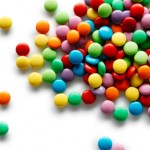I've always been suspicious of food dyes. Reading labels and seeing Red 40 and Yellow 6 made me wonder if they added any benefit, other than allowing the food companies to sell more of their product. Then we were in Maryland, near the end of an eleven day trip to visit kids and grandkids and old friends and I spotted an article in the Washington Post titled "Eye-catching foods to get closer look from regulators." Today the Wall Street Journal and The New York Times had similar articles.
So I went back to an online 2007 British article published by professional staff from two medical schools which, in a randomized, double-blinded, placebo-controlled trial showed adverse effects (hyperactivity) from one mxture of artifical food color and additives. In 2008 the non-profit Center for Science in the Public Interest, calling those dyes the "Secret Shame" of food industry and regulators, petitioned the FDA to ban them, noting several of them were already being phased out in the United Kingdom.
CSPI noted that a 2004 meta-analysis had shown that those dyes can affect children's behavior and quoted two more recent British government-funded studies of kids in a general population that had also concluded that the dyes and a preservative (sodium benzoate) had adverse effects on behavior.
So what happened? You got it. The FDA didn't ban the dyes.
In June of 2010 CSPI published another article that raised issues beyond hyperactivity, namely cancer and allergic reactions. They commented that our public is exposed by the food manufacturers to roughly fifteen million pounds per year of eight synthetic dyes. Three of those dyes are contaminated with known carcinogens, CSPI said, and a fourth, Red 3, was already acknowledged to be a carcinogen by the FDA itself.
Three of the four plus Blue 1 can cause allergic reactions in some people; this is not new knowledge according to CSPI.
Why do the food companies use the dyes? They're eye-catching and kids look for bright colors. CSPI urged the FDA to ban the dyes since there is evidence in human and animal studies of potential harm from them, but none of helpful effect, except to the wallets of the food producers.
That article came out in late June of 2010. Now in late March of 2011 the FDA is convening a panel of experts with the comment that artificial food dye is an issue "for certain susceptible children with ADHD and other problem behaviors."
I'm not betting on the outcome of the panel's recommendations, at least not from the FDA. On the other hand the food industry may be catching on. Some may try natural colors and I saw a mention of a new Koolaid product, Koolaid Invisible.
In the meantime, maybe it's time to wean your kids off of M&Ms.

